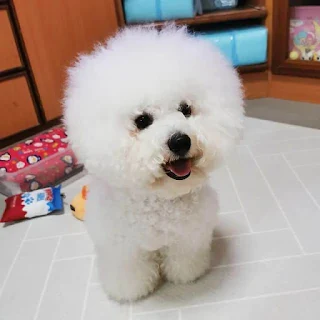Many are unaware that there are different types of Bichon, but in reality there are four types, all recognized by the International Canine Federation (FCI).
Bichon dogs, in general, are friendly and brave, and greet everyone as a close friend. They have an appealing appearance, and their lively, energetic nature makes them great companion pets. Bichons also stand out as therapy dogs and competitors in canine sports like agility and tracking.
This breed is highly intelligent, and boasts a beautiful, soft coat, expressive eyes, and a commanding presence when walking.
Let's look at each breed separately to learn about their similarities and, above all, their differences.
Maltese, elegance and balance
- Size: 7-12inches
- Weight: 4-8 pounds
- Average life span: 12-15 years
The Maltese is a loving dog covered with a long, soft and silky coat.
Underneath the all-white coat, there is a compact body that can move smoothly and easily, giving a sense of gentle elegance and poise.
They are guard dogs, fearless, charming and small athletes in the field of sport.
Maltese are reserved, live for many years and are always happy to meet new people.
They can often be a bit stubborn, but respond well to training with praise.
Read also: Bichon Frise vs Maltese What's the Difference
History
Among the bichons, the Maltese is one of the oldest.
Its history dates back to the Pharaoh's era, where some records of these dogs were found in Egypt.
This breed was well known in Italy during the time of Emperor Claudius and there are still statues depicting them.
Aristotle called them the favorite of women; writers mentioned their beauty; and the Greeks loved them very much.
Moreover, in their honor, they built a tomb for them.
Titian's paintings of 1576 show that his dog was very similar to the Maltese and during the Renaissance, it was the most popular dog in the Middle Ages.
The name Maltese comes from the island of Malta, but its exact origin is not clear.
However, it is considered a very old dog and a descendant of the Spitz.
Often, this breed is crossed with other small dogs to produce the so-called designer dogs.
Characteristics of the Maltese
This is a pet that is selectively designed to be with royalty, it has a head that does not deform its body so everything is finely created to be in symmetry.
He has a long muzzle covered with long hair and has a big black nose. All these features make him look very elegant.
His eyes are oval, extravagantly shaped and have a deep black color. He has ears that are covered with long, floppy hair. The tail is full of fur, but with a curly outline, giving him a bearing of distinction different from the others.
Its coat is very elegant, with an impressive silkiness and is very fine, which makes its appearance refined. It is pure white or pearly white, and is partially open in the middle of the back.
Maltese personality
This breed is perfect for large families because of its personality. They are affectionate dogs with other animals, pets, and people in their environment, as well as very obedient and intelligent.
Grooming and food care
The coat should be brushed and washed regularly.
Cleanliness and care is an essential part of a beautiful and healthy coat.
The adopter should keep the fur around their eyes, ears and soles of their paws low, so that it does not increase in volume.
A proper diet is essential to maintain the characteristic Maltese appearance, otherwise his coat will turn yellow and some spots may appear.
The best feeds for this breed include saltwater fish, poultry, lamb, brown rice, avocado and wheat.
Maltese dogs rarely shed hair, making it a good dog for allergy sufferers.
In addition, this provides minimal maintenance for the family in terms of grooming and allergy medications.
Living conditions
This breed lives well in small apartments, with a loving adopter around who has enough time to care for him every day.
His physical activity level is low, but he does not refuse to walk once in a while.
It is important to help him socialize and train him.
Education
His temperament and personality make him a perfect dog to be well educated, because he loves to please his adopter.
Although, it is important that the adopter is gentle, but at the same time consistent, because they are very sensitive to loud voices. Maltese Dog Information
Bichon Frise, an excellent companion dog
- Size: 9-12 inches
- Weight: 7-12 lbs
- Average life span: 12 - 15 years
The Bichon Frise is a small, compact dog with a shaggy white coat. This breed is a popular choice for families as they make wonderful social pets.
Bichon Frises are known for their charming and friendly personalities, and they love to go for walks with their family. They get along well with other pets and are great with children.
This breed is obedient and quick to learn new skills. However, potential adopters should be aware of potential health issues, particularly in the eyes, ears, and skin. Bichon Frises are prone to seizures and knee dislocations.
History of the Bichon Frise
The Bichon Frise is commonly thought to be a French breed, but it actually originated in Spain. It is part of the Barbizon Group, along with the Maltese, Havanese, and Bolognese breeds. The Bichon Frise is believed to have originated in Tenerife, one of the Canary Islands.
This breed became a popular choice for travelers and nobles due to its compact size and cheerful personality. Additionally, its soft coat and charming demeanor made it a favorite of French and Italian ladies during this time.
Physical description
The Bichon Frise is a compact dog with a round black nose, spherical eyes, and long, droopy ears that are covered in abundant, fluffy hair. Its medium-length tail is curved and held high, but not fixed to the back, and is covered in long hair that cascades down.
This breed has a thick coat that may sometimes form perfect waves or curls.
Temperament
The Bichon Frise shares a similar personality to other bichon breeds, but is known for its especially docile, sociable, and intelligent temperament.
One of the reasons why this breed is perfect as a pet is its patience and tolerance with children. They are extremely gentle and calm, making them great companions for families.
Grooming
To maintain its beautiful white coat, the Bichon Frise's hair should be combed once a day and trimmed regularly to prevent it from getting too long. It is also important to wash the coat regularly to keep it well-groomed.
Living conditions
The Bichon Frise adapts easily to the conditions and lifestyle of its adopter, and feels happy and comfortable when surrounded by people who love it.
This breed enjoys being with its adopter most of the day and accompanying them everywhere, and can create a strong bond with its owner.
Training
With continuous, varied, and gentle training, the Bichon Frise can easily achieve the desired results. This intelligent breed quickly grasps what is being taught to them.
Related: Bichon Frise feeding
Havanese, intelligent, extroverted, funny
- Size: 8-11 inches
- Weight: Between 7-13 pounds
- Average life span: 14-16 years
It is a breed that stands out for its long, silky coat, expressive eyes and size. It was an ideal companion dog for Cuban nobles in the 19th century, nicknamed Velcro dog, because they were so close to their adopters.
Havanese show affectionate personalities with everyone, including strangers, children, other dogs and cats. They are small, cheerful, fast walking dogs with bright brown eyes.
They make excellent lively, outgoing companions.
History
The Bichon Havanese is the national dog of Cuba. They are small dogs, which were crossed with other dogs on the island. This breed comes from the western Mediterranean region.
The resurgence of the breed began in the seventies, when some breeders began to study the breed and realized that they bred these dogs.
Characteristics of the Havanese
It is a small but vigorous dog, with a head that is proportional to the body, with a trapezoidal shape. With a wide and flat skull, a thin muzzle, a slightly high forehead, the eyes are almond-shaped, large and very dark.
The ears are needle-shaped, not very long, drooping and covered with long hair. The tail is always held up. The coat is long, silky, smooth, dense, with tufts of hair on the extremities. Their weight is between 3.6 and 6.8 kg.
Temperament
It is an extremely lively dog, always cheerful, gentle, sociable, persevering, obedient and loyal to its adopter.
If children do not abuse him, he will get along well with children, otherwise he will be isolated for a while with other dogs and pets. He can be trained as an alarm or guard dog. He is a super active and very smart dog.
If properly socialized he will be a calm dog. Otherwise, he could be aggressive with other dogs, nervous and shy. He does not trust strangers very much.
Grooming
One of the things the adopter should keep in mind is to comb his coat two to three times a week, in order to keep it free of dead hair and avoid tangles.
In addition, the hair on the paws should be trimmed so that it does not hinder their movement.
Living conditions
It is a dog with little need for activity or exercise. It is easy for them to adapt to the daily living conditions of the adopter.
In the apartment or home of a loving family, he feels well, but it is important to have time to take care of him every day.
Also read: How to keep a dog happy and healthy in a small apartment.
He likes short, frequent walks outdoors and it is recommended to take them once a day. He needs socialization and training like any other dog.
Training
The dog is sensitive to tone, wants to please his adopter and can easily understand his requests. Therefore, training from an early age will not be a problem. Read more on havanese dog
Bolognese, playful and tolerant
- Size: 10-12 inches
- Weight: 7-14 pounds
- Average life span: 12-14 years
The Bolognese is a small companion dog originally from Italy, calm and faithful, with pure white and fluffy hair.
They are very funny, quiet; and like the others, it can be very quiet and inactive. It is a pet devoted to its family and comfort.
Bolognese are prone to separation anxiety and cannot be left alone for long periods of time.
The Bolognese is an ancient breed, known to nobles in Roman times, and they were a precious gift among wealthy and powerful people.
History
A Bolognese, originally called Italian Bichon, was brought by the sailors of the 15th century, having a breeding in Bologna, that is why it is known as Bolognese.
Because of its beauty and elegance, it was highly valued, especially in the royal families of Italy, Spain and Russia.
The wife of Peter the Great, Catherine de Medici, Catherine I and the wife of Empress Maria Theresa of Austria, had these dogs as companions.
Temperament
It is an intelligent dog, elegant and very gentle with everyone and with children. They are very calm, obedient, and loyal to their family.
They are a cautious pet with people they do not know, but are very sociable and affectionate with other animals and pets.
Grooming
The coat should be brushed and groomed daily to avoid tangles, especially on the abdomen, behind the ears and between the legs. Removing dead fur is very important, so you can help with a brush and comb it regularly.
One of the things the adopter should do is to remove excess hair on the paws and ears. The skin should be washed regularly to keep it white and healthy.
Living conditions
It is a pet that will do best in the apartment or home of an attentive adopter. The adopter should have enough time to care for his coat. Their activity level is medium, but they can also enjoy long trips.





